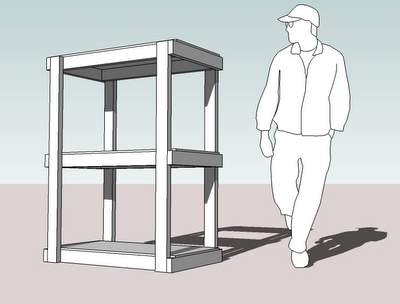A Quick Guide On How To Build Shelving In Your Shed
Learning how to build shelving is pretty quick and easy. It's one of the fastest ways to increase your shed storage and free up valuable floor space for larger items.
Here's a quick guide to building shed shelves to easily boost your storage space in a matter of hours:
What type of shelving?
If you're thinking about how to build shelving the first thing to consider is the type of shelves you require. Don't forget that we're talking about putting shelves inside a shed here, so they need to be practical and functional first, and style is much less of an issue. That's because the items you're going to store will probably scratch and make your shelves dirty. You don't want to have to be constantly worried about touching up the marks of wear and tear. That's why timber and plywood are one of the best options for building shelves in a shed, because they're durable, fairly inexpensive and will hold a good weight.
Next, have a good think about the kind of things you want to store and this will help you decide the material and style of shelving to choose.
Here are a few ideas of materials that you can use:
- Left-over timber you bought to build your shed to create shelves
- Pick up some scrap timber from a lumber yard and use metal shelf supports for added strength
- Buy a plastic shelf kit which comes readymade, pre drilled and very simple to install. If you have a plastic shed, most manufacturers will provide shelf accessory kits specifically designed to fityour shed.
- Use wire mesh shelves supported by metal brackets. The mesh will allow air to circulate around your belongings and help prevent damage from the elements
- Add a wooden peg board alongside your shelves to hang small tools. You can also add hooks to the edges of your shelves for hanging odds and ends such as string, gloves and light weight tools.
How to build shelving from timber
The picture below shows how to make some simple but strong shelves from 4x2 timber. First cut out the shelf size you require from 12mm (1/2 inch) plywood and nail a piece of 2x4 to the underneath of the front, back and sides.
Use vertical 2x4s for the supports at the front and back to form the suport frame. The maximum span of the plywood should be about 450mm (18inches) back to front. The maximum spacing of the vertical supports along the run of the shelves should be 1.2m (4 feet).
If you are storing relatively light items on these shelves then they will be stable using the screws/nails that you have used to fix the members together. If you are storing heavy tools etc. then I would recommend that you fix the shelving unit back to the shed wall or add some diagonal bracing for extra stability.
These shelves don't need treating if they are inside but you can paint or stain them if you like which will help to stop them gathering ingrained dirt.
 Typical arrangement for basic timber shelving
Typical arrangement for basic timber shelving
Freestanding shelving for sheds
If you don't want the hassle or have the time to learn how to build shelving yourself you can buy really good freestanding utility shelves, cabinets or drawers. These are great for storing tools, gardening equipment and heavy items. Just check the maximum load per shelf and shop around to get the best price. Good places to pick up a bargains online are Home Depot, Amazon and eBay.
Related posts:
- A review of the quick and easy plastic shelves from Keter
- Strong metal shelves for your shed
- Are you planning shelves for your garden office?

Keep in touch with our monthly newsletter
Shed Building Monthly




